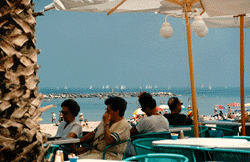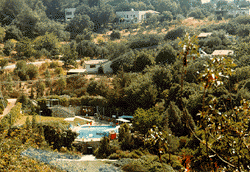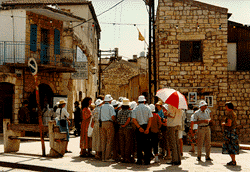Special Feature: Products Sally Recommends
Galilee: The Green North of Israel
 The city of Tel Aviv is not in itself terribly impressive. Only built with limited funds and expertise in the 1920's by immigrant settlers from Central Europe, much of it still makes a somewhat jerrybuilt impression. Most buildings are concrete and are not yet old enough to acquire the subtle patina which gives their counterparts in cities like Athens a certain charm.
The city of Tel Aviv is not in itself terribly impressive. Only built with limited funds and expertise in the 1920's by immigrant settlers from Central Europe, much of it still makes a somewhat jerrybuilt impression. Most buildings are concrete and are not yet old enough to acquire the subtle patina which gives their counterparts in cities like Athens a certain charm.
Many of these older structures are now being pulled down and replaced with more modern ones, yet even with these we got the impression that downtown Tel Aviv is a city designed more for function than for appearance. We spent little time in the inner city and headed for Jaffa (or Yafo, as it is called by the Israelis), the old Arab section along the waterfront.
In the 1800's this was the only town in the area and was surrounded by desert. Now it has been beautifully restored and made into an outstanding tourist attraction, with excellent restaurants, boutiques, handicraft shops and spacious parks (a rarity in downtown Tel Aviv).
Between some of the buildings we found our first archeological excavations, a sight we would become accustomed to as we traveled in Israel. The Israelis are, without a doubt, the most history conscious and archeologically minded people we have met anywhere. A mention of historic sites will bring a gleam into any Israeli's eye. Sunset across the Mediterranean here was an inspiring sight as we returned to our hotel, planning to leave the city the next morning.
 Heading out of central Tel Aviv, the standard of houses and gardens improved dramatically. Soon we were passing through Herzlia which, on a visit only a few years ago, was a separate resort township but had now become a pleasant dormitory suburb for Tel Aviv.
Heading out of central Tel Aviv, the standard of houses and gardens improved dramatically. Soon we were passing through Herzlia which, on a visit only a few years ago, was a separate resort township but had now become a pleasant dormitory suburb for Tel Aviv.
Oranges were one of the early exports of the Jewish farmers in Palestine and later Israel, and the lush greenery of the trees and large vivid-orange fruit once extended as far as the eye could see. Sadly, the entry of Greece and Spain into the European economic community is making the cultivation of the famous Jaffa oranges uncompetitive. We saw many groves being uprooted to make way for newer, more readily marketable crops.
A little further along, where the highway had turned somewhat inland, we saw the sign "Caesaria" and turned off the road towards this ancient town. Here was the largest Roman city in this area, named in honor of the Emperor Augustus. After the Jewish revolt against Rome in 66 AD. Caesaria became a Roman colony and capital of the Province of Judea. During the 4th Century it was the most important urban center in the Holy Land.
In 640 AD it was captured by the Arabs and subsequently conquered by the Crusaders in 1107. These invaders built fortifications which have been magnificently restored by the Israelis. You find relics of the past everywhere. Here stands a Roman viaduct that carried water from underground springs, there is the Crusader's moat. Explanatory signs in English and Hebrew give meaning to all the excavations.
Leaving Caesaria on our way to Haifa, we passed some very modern homes, many of them belonging to retired Americans who spend winter in this area.
It would be hard to imagine two cities more unalike than Tel Aviv and Haifa. Haifa is very European, as opposed to Mediterranean. Much of the character of this city, the third largest in Israel, can be traced to the German Templar settlers who established a colony here in the late 1800's. The architecture reflects this heritage .
Haifa houses would seem appropriate in the south of France or central Europe. The gardens here are green and fresh, and even the townspeople here seem to be more central European in origin than those in Tel Aviv, where a greater proportion of recent settlers originated from North African countries.
We spent a day visiting the many interesting sights around Haifa. The Technion was our first stop. This technical university is rated as one of the most advanced centers of high-technology research in the world and only the very brightest students are accepted here. The areas of study are extremely diverse, covering: aeronautics, computers sophisticated electronic technology, water conservation and agriculture in incredibly hostile environments.
The Israelis are world leaders in water conservation, and few people know that the Technion is helping an unlikely list of other countries, from north and central Africa to USA, Mexico, China, Turkey, Egypt, Jordan and former Soviet areas like Kazakhstan, adopt this technology. Other Technion departments research such seemingly impossible tasks as computer-calculated muscle stimulation which, it is hoped, will eventually enable paraplegics to regain the limited ability to walk.
Back at Mount Carmel, the city panorama spread out below us. Gleaming in the sunlight, the golden dome of the Bahai Temple stood out. This is the center of the Bahai religion, and is set in the most splendid gardens imaginable. A feature of these is that they contain one specie of every type of plant from around the world that will grow here, a symbolic representation that God belongs to all.
After driving through some of the lovely suburbs on Mount Carmel, and visiting the Haifa Maritime Museum, we set off for Acre.
Called Akko by the Israelis and Akka by the Arabs, this town dates back to the time of the ancient Canaanites. The Israelites who followed did not have the area to themselves for long. The Ancient Greeks came, then the Romans, then Arabs and after that the town was made into a major fortress by the Crusaders. Here history records that the city withstood 17 sieges. It is a fascinating town to explore. We wandered through the narrow streets through which Richard the Lionheart and Philip Augustus of France may have walked after capturing the town, and visited the Arab market with its pungent smell of spices.
Back into the car, and soon we left the coast, making for Kibbutz Ayelet Hashahar in the Upper Galilee. This is one of the oldest kibbutzim in the country, founded in 1915 by young people from Russia. With hard work and great dedication they changed a dry, barren area into the fertile green lands which we now saw.
A kibbutz experience is a must for any visitor to Israel. Many of these establishments accept volunteers for six weeks to a years work, and have excellent, clean guest-houses of superior motel standard. Here visitors can stay and observe the communal Kibbutz lifestyle which works so successfully in Israel.
At Ayelet Hashahar one now finds 1,000 members from some 30 countries and they will be happy to take you on a tour of this co-operative agricultural settlement. The basic principle here is that everybody shares in both the labor and benefits. Everything from housing to medical services is provided by the Kibbutz which also gives members such basics as pocket money, life insurance and retirement facilities. Management is by committee, and all purchases for the kibbutz, as well as the marketing of its produce, are handled by committees or managers appointed by its members. In this way, everybody has a personal voice and involvement.
Today this Kibbutz is one of the larger fruit producers in the country. It also has dairy cattle, poultry and beehives which make it a major producer of Israel's honey. Fish ponds at the kibbutz get their water supply from canals draining the former Huleh Swamps nearby. There is also a factory on the complex, equipped with the most advanced machinery for making molds used in the production of tires.
 Israel is an interesting and complex country with growing tourism. Apart from the visitor who goes there because of the religious sites, Israel is now getting a large number of businessmen who call on the newly-emerging Middle Eastern market created by Israeli/Arab joint ventures. Scandinavia or northern Europeans go there to escape the cold weather months. Others are young people who visit for the Kibbutz experience, and those interested in history who usually combine Israel, Jordan and Egypt in their itineraries.
Israel is an interesting and complex country with growing tourism. Apart from the visitor who goes there because of the religious sites, Israel is now getting a large number of businessmen who call on the newly-emerging Middle Eastern market created by Israeli/Arab joint ventures. Scandinavia or northern Europeans go there to escape the cold weather months. Others are young people who visit for the Kibbutz experience, and those interested in history who usually combine Israel, Jordan and Egypt in their itineraries.
If you are planning a visit to Israel, a few days in the Galilee will give you an excellent insight into what makes this fascinating country tick.
![]()
When to go:
Best time to go is in the cooler months between October and May.
Getting there:
The airline El Al runs direct services to Tel Aviv.
What to take:
Take comfortable, casual clothing and good walking shoes.
Take US dollars or US dollar travelers' checks.
![]()
Walter & Cherie Glaser are an international travel-writing team based down under in Melbourne, Australia.
Note: This information was accurate when it was published. Please be sure to confirm all rates and details directly with the businesses in question before making your plans.



